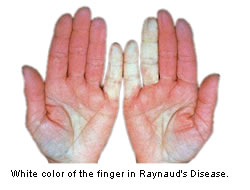During this cold winter that we have been experiencing, I would like to take this opportunity to highlight the issue of cold intolerance, also known as Raynaud’s.
Vasospasm
Raynaud’s (vasospasm) is the body’s response to stress or a traumatic event. It may be a freestanding problem, also known as Raynaud’s disease, or may be a secondary reaction to an underlying medical problem, known as Raynaud’s phenomenon.
Is more common in women, and families, and those people living in colder acclimates. It will feel as if you have lost the circulation in your hands or feet, but in fact the reason for this feeling is due to vasospasm, and not lack of circulation. Vasospasm is the regulation of blood flow, and as a result of the stress the body’s protective mechanism will dilate those blood vessels that supply essential portions of the body (heart, liver, brain, kidneys, etc.), and constrict the blood vessels that feed into the periphery (tips of the fingers, tips of the toes, lips, nose, and ears). When the stress has passed there will be a re-dilatation to the blood vessels in the periphery. Hence, the associated color changes; white, then blue, and upon rewarming red. There may also be associated symptoms of numbness, throbbing, tingling, and or swelling.
Raynaud’s disease
The most common type is Raynaud’s disease, without an identifiable underlying medical condition.
Raynaud’s phenomenon or secondary Raynaud’s, will occur as the result of an underlying medical condition, and may occur later in life. Several of these medical issues include: Thyroid disease, lupus, scleroderma, rheumatoid arthritis, and carpal tunnel syndrome. Other factors that contribute include; smoking, repetitive stress injuries, and/or vibration (such as use of power tools and jackhammer’s). Certain medications have also been linked to these symptoms, and these include the beta blockers, used to treat hypertension, medications used to treat migraines, and medications that are used to treat attention deficit disorder, and hyperactivity.
Diagnosis
When first diagnosed is important to have a thorough medical workup, to determine if there is an underlying issue which can be treated. Once this treatment begins, very often the symptoms will resolve.
Treatment Of Raynaud’s Disease
In general local measures are recommended as the mainstay of treatment. Keeping the area warm, by using mittens instead of gloves on the hands, and heavy woolen socks on the feet to protect the toes. Try to get indoors as quickly as possible into a warmer environment. Massaging your hands and feet will be of benefit, wiggling the fingers and toes may also be beneficial. Using hot water on the area affected would be more detrimental; however, using warm water from the tap will help in the rewarming process.
Other measures to help reduce the symptoms would include cessation of smoking, exercise, and controlling stress.
The goals of treatment are to reduce the severity of attacks, prevent tissue damage, and if applicable to treat the underlying medical condition. No one medication as a treatment has had any great success. However, certain medications have been used including nifedipine, Norvasc, Minipress, Cardura, Cozaar, and even Viagra. Use of local nitroglycerin cream to the toes or the fingers may help dilate the local blood vessels in the area. However, the use of any of these medications must be discussed with your medical doctor. As they all have potential side effects.
There are those medications that may worsen the symptoms, including beta blockers which are being used to treat high blood pressure, including Lopressor, Toprol, Corgard, and Inderal. Over the counter cold remedies which include pseudoephedrine should also be avoided. Excessive alcohol consumption should also be avoided, as it initially may cause a vasodilatation, but then cause a rebound in the vasospasm, making the symptoms feel even worse.
Other options for treatment may include use of fish oils, biofeedback, acupuncture, and where applicable local nerve blocks to maintain the vessels at maximum dilatation.

